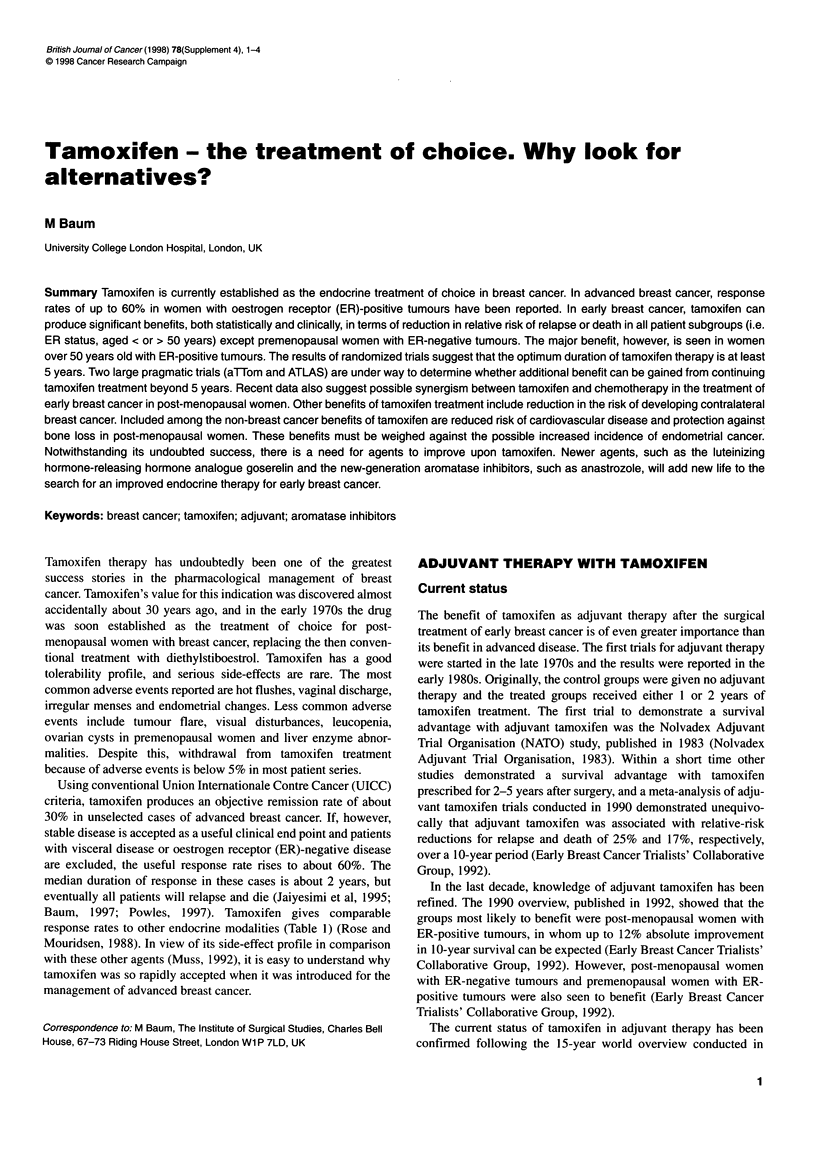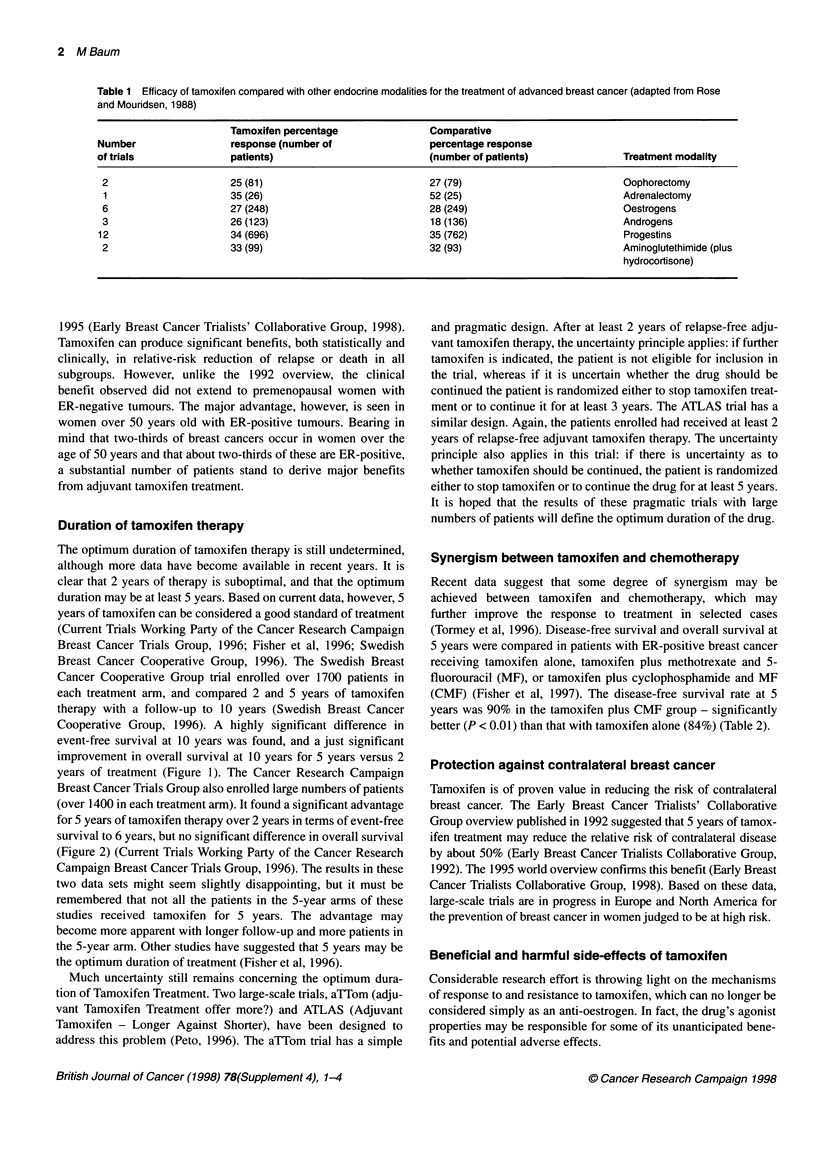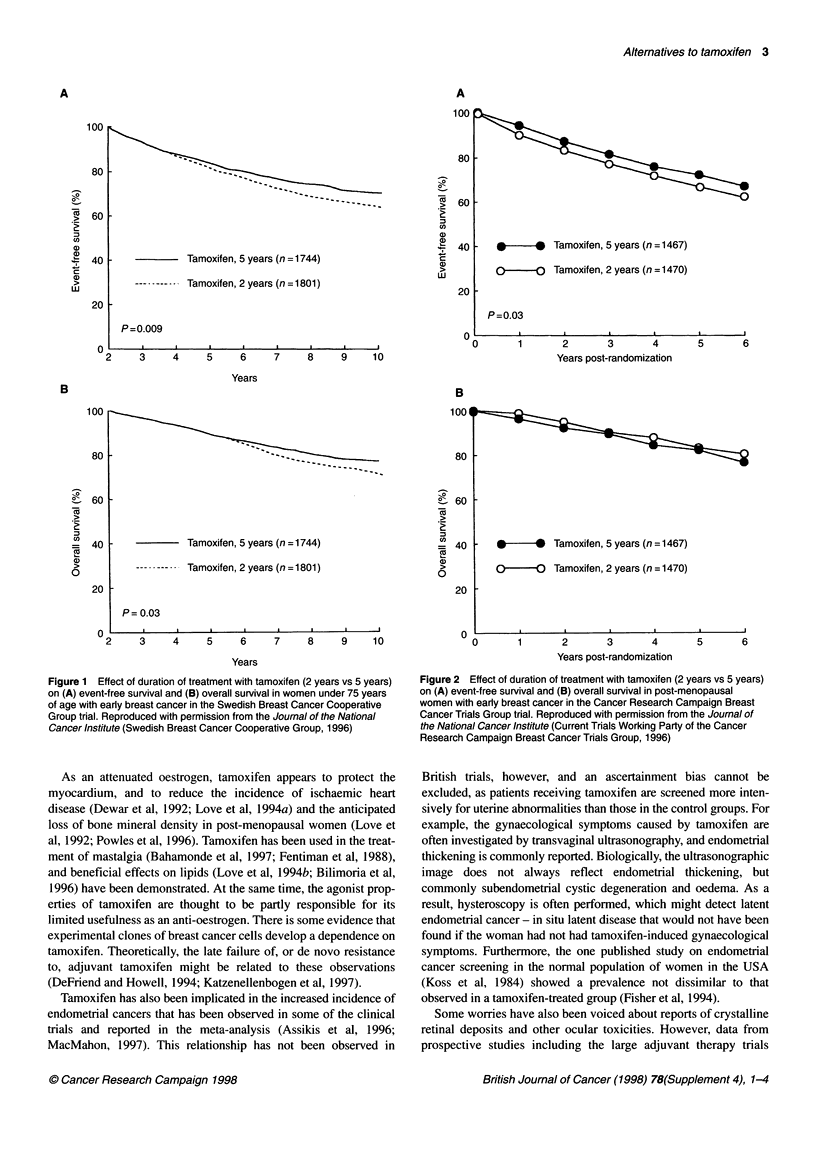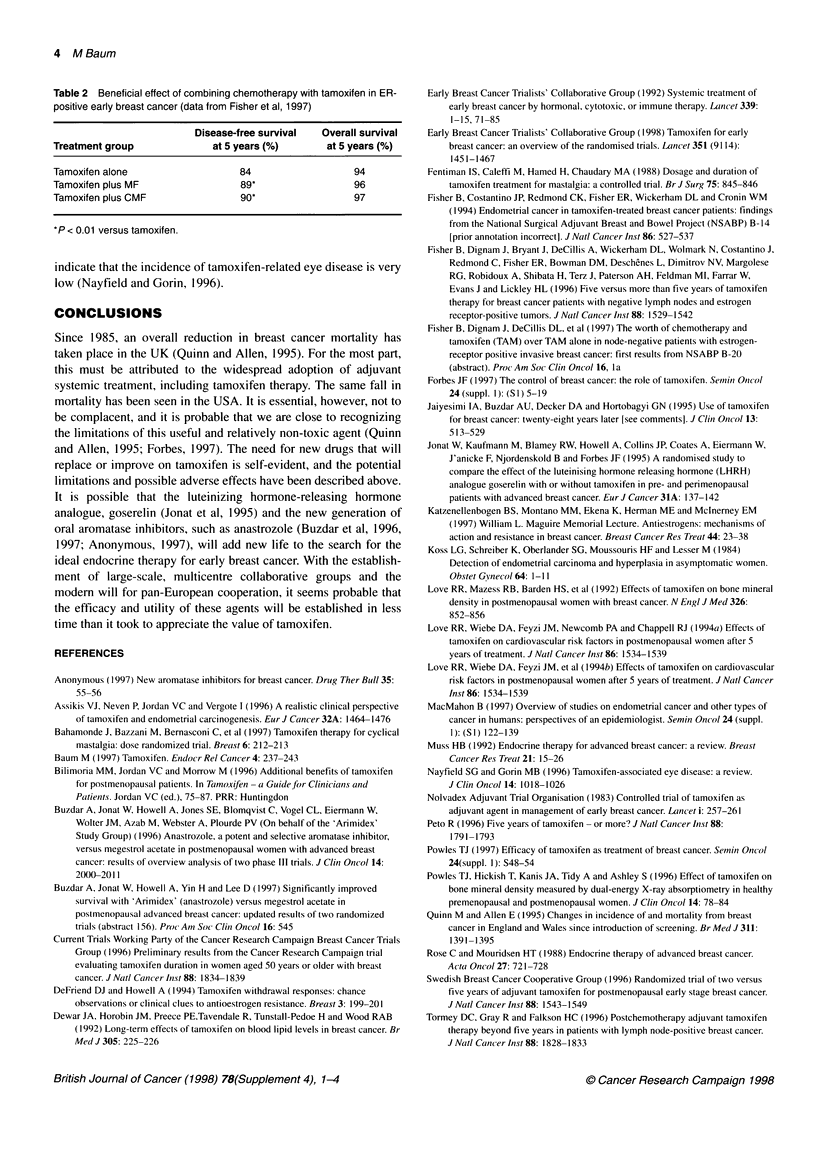Abstract
Tamoxifen is currently established as the endocrine treatment of choice in breast cancer. In advanced breast cancer, response rates of up to 60% in women with oestrogen receptor (ER)-positive tumours have been reported. In early breast cancer, tamoxifen can produce significant benefits, both statistically and clinically, in terms of reduction in relative risk of relapse or death in all patient subgroups (i.e. ER status, aged < or > 50 years) except premenopausal women with ER-negative tumours. The major benefit, however, is seen in women over 50 years old with ER-positive tumours. The results of randomized trials suggest that the optimum duration of tamoxifen therapy is at least 5 years. Two large pragmatic trials (aTTom and ATLAS) are under way to determine whether additional benefit can be gained from continuing tamoxifen treatment beyond 5 years. Recent data also suggest possible synergism between tamoxifen and chemotherapy in the treatment of early breast cancer in post-menopausal women. Other benefits of tamoxifen treatment include reduction in the risk of developing contralateral breast cancer. Included among the non-breast cancer benefits of tamoxifen are reduced risk of cardiovascular disease and protection against bone loss in post-menopausal women. These benefits must be weighed against the possible increased incidence of endometrial cancer. Notwithstanding its undoubted success, there is a need for agents to improve upon tamoxifen. Newer agents, such as the luteinizing hormone-releasing hormone analogue goserelin and the new-generation aromatase inhibitors, such as anastrozole, will add new life to the search for an improved endocrine therapy for early breast cancer.
Full text
PDF



Selected References
These references are in PubMed. This may not be the complete list of references from this article.
- Assikis V. J., Neven P., Jordan V. C., Vergote I. A realistic clinical perspective of tamoxifen and endometrial carcinogenesis. Eur J Cancer. 1996 Aug;32A(9):1464–1476. doi: 10.1016/0959-8049(96)00184-0. [DOI] [PubMed] [Google Scholar]
- Buzdar A., Jonat W., Howell A., Jones S. E., Blomqvist C., Vogel C. L., Eiermann W., Wolter J. M., Azab M., Webster A. Anastrozole, a potent and selective aromatase inhibitor, versus megestrol acetate in postmenopausal women with advanced breast cancer: results of overview analysis of two phase III trials. Arimidex Study Group. J Clin Oncol. 1996 Jul;14(7):2000–2011. doi: 10.1200/JCO.1996.14.7.2000. [DOI] [PubMed] [Google Scholar]
- Dewar J. A., Horobin J. M., Preece P. E., Tavendale R., Tunstall-Pedoe H., Wood R. A. Long term effects of tamoxifen on blood lipid values in breast cancer. BMJ. 1992 Jul 25;305(6847):225–226. doi: 10.1136/bmj.305.6847.225. [DOI] [PMC free article] [PubMed] [Google Scholar]
- Fentiman I. S., Caleffi M., Hamed H., Chaudary M. A. Dosage and duration of tamoxifen treatment for mastalgia: a controlled trial. Br J Surg. 1988 Sep;75(9):845–846. doi: 10.1002/bjs.1800750905. [DOI] [PubMed] [Google Scholar]
- Fisher B., Dignam J., Bryant J., DeCillis A., Wickerham D. L., Wolmark N., Costantino J., Redmond C., Fisher E. R., Bowman D. M. Five versus more than five years of tamoxifen therapy for breast cancer patients with negative lymph nodes and estrogen receptor-positive tumors. J Natl Cancer Inst. 1996 Nov 6;88(21):1529–1542. doi: 10.1093/jnci/88.21.1529. [DOI] [PubMed] [Google Scholar]
- Jaiyesimi I. A., Buzdar A. U., Decker D. A., Hortobagyi G. N. Use of tamoxifen for breast cancer: twenty-eight years later. J Clin Oncol. 1995 Feb;13(2):513–529. doi: 10.1200/JCO.1995.13.2.513. [DOI] [PubMed] [Google Scholar]
- Jonat W., Kaufmann M., Blamey R. W., Howell A., Collins J. P., Coates A., Eiermann W., Jänicke F., Njordenskold B., Forbes J. F. A randomised study to compare the effect of the luteinising hormone releasing hormone (LHRH) analogue goserelin with or without tamoxifen in pre- and perimenopausal patients with advanced breast cancer. Eur J Cancer. 1995;31A(2):137–142. doi: 10.1016/0959-8049(94)00415-2. [DOI] [PubMed] [Google Scholar]
- Katzenellenbogen B. S., Montano M. M., Ekena K., Herman M. E., McInerney E. M. William L. McGuire Memorial Lecture. Antiestrogens: mechanisms of action and resistance in breast cancer. Breast Cancer Res Treat. 1997 May;44(1):23–38. doi: 10.1023/a:1005835428423. [DOI] [PubMed] [Google Scholar]
- Koss L. G., Schreiber K., Oberlander S. G., Moussouris H. F., Lesser M. Detection of endometrial carcinoma and hyperplasia in asymptomatic women. Obstet Gynecol. 1984 Jul;64(1):1–11. [PubMed] [Google Scholar]
- Love R. R., Mazess R. B., Barden H. S., Epstein S., Newcomb P. A., Jordan V. C., Carbone P. P., DeMets D. L. Effects of tamoxifen on bone mineral density in postmenopausal women with breast cancer. N Engl J Med. 1992 Mar 26;326(13):852–856. doi: 10.1056/NEJM199203263261302. [DOI] [PubMed] [Google Scholar]
- Love R. R., Wiebe D. A., Feyzi J. M., Newcomb P. A., Chappell R. J. Effects of tamoxifen on cardiovascular risk factors in postmenopausal women after 5 years of treatment. J Natl Cancer Inst. 1994 Oct 19;86(20):1534–1539. doi: 10.1093/jnci/86.20.1534. [DOI] [PubMed] [Google Scholar]
- Muss H. B. Endocrine therapy for advanced breast cancer: a review. Breast Cancer Res Treat. 1992;21(1):15–26. doi: 10.1007/BF01811960. [DOI] [PubMed] [Google Scholar]
- Nayfield S. G., Gorin M. B. Tamoxifen-associated eye disease. A review. J Clin Oncol. 1996 Mar;14(3):1018–1026. doi: 10.1200/JCO.1996.14.3.1018. [DOI] [PubMed] [Google Scholar]
- Quinn M., Allen E. Changes in incidence of and mortality from breast cancer in England and Wales since introduction of screening. United Kingdom Association of Cancer Registries. BMJ. 1995 Nov 25;311(7017):1391–1395. doi: 10.1136/bmj.311.7017.1391. [DOI] [PMC free article] [PubMed] [Google Scholar]
- Rose C., Mouridsen H. T. Endocrine therapy of advanced breast cancer. Acta Oncol. 1988;27(6A):721–728. doi: 10.3109/02841868809091775. [DOI] [PubMed] [Google Scholar]


